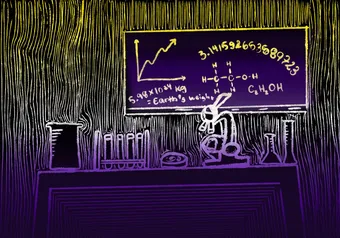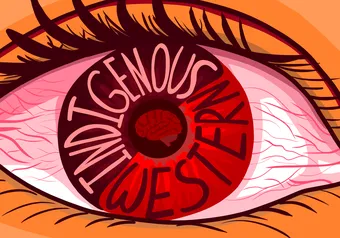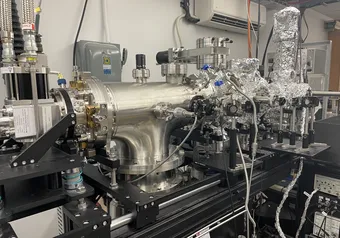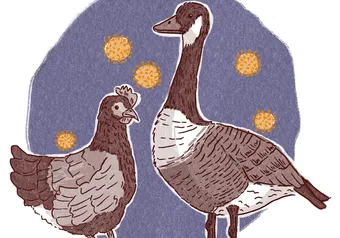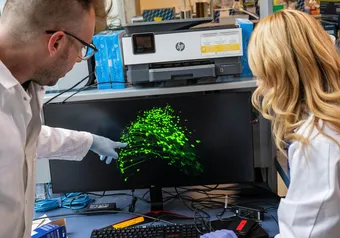On May 11, the Ecosystem Services, Commercialization Platforms and Entrepreneurship (ECOSCOPE) training program celebrated nearly six years of work with a symposium featuring student findings.
Founded after program director Dr. Steven Hallam received a grant from the National Science and Engineering Research Council of Canada (NSERC) to start the project, ECOSCOPE has provided training for hundreds across UBC.
NSERC’s $1.65 million Collaborative Research and Training Experience (CREATE) is a six-year program designed to provide interdisciplinary training for graduate students.
Hallam’s specific goal was to support students at the intersection of business, data science and biology. The conference marks the end of the program's core educational initiatives.
“We developed this idea that we could bring across different faculties, students that were interested in developing microbial biotechnology,” he said in an interview with The Ubyssey. Hallam wanted ECOSCOPE to cultivate research focusing on environmental impact in fields as disparate as mining engineering and immunology.
To raise the potential impact of student work, he also sought to encourage entrepreneurial thinking through arranging internships at startups, networking opportunities and training events.
ECOSCOPE’s cornerstone cohort program sponsored four groups of graduate students. Each cohort combined biotechnology with entrepreneurship fundamentals through mentorship and “core courses” such as the Sauder School of Business course Technology Entrepreneurship for Engineers (APSC 541).
The learning initiative has further provided public workshops, hosted science events and supported dozens of other UBC projects, including the university’s award-winning International Genetically Engineered Machines team.
Gathering students to explore research outcomes
The May 11 conference hosted speakers, graduate presentations and a poster session from affiliated researchers.
Researchers ranging from food scientists to civil engineers participated. “[We have] a very diverse, eclectic faculty framework, bringing lots of different students together,” said Hallam. The symposium featured cheese microbiome scholars (Dr. Justin Falardeau, "The curious case of Streptococcus thermophilius") alongside developers of fluorescent chromosome markers (Avery Noonan, "Chromosomal marker genes to measure population dynamics and improve high-throughput screening outcomes") in a series of talks and poster sessions.
During an informal feedback session, ECOSCOPE community members took time to reflect on their work at the training program.
“One of the fascinating things to me was the way the goal of entrepreneurship … brought in some challenging barriers,” said PhD candidate Carmen Bayly, a member of ECOSCOPE’s third trainee cohort. “What can we do with [our ideas] is one question, but [asking] what can we do in a way that can generate income, that’s going to be something that can work on the scale of business [is different].”
Demonstrating the potential of microbiology research
The symposium hosted three keynote speakers who explored the industrial and commercial applications of their work in microbiology, synthetic biology and biochemical engineering.
“I believe that biology is the solution,” said one keynote speaker, Director of the Synthetic Biology Hive at Harvard Medical School Dr. Pamela Silver. “But can we do better? Can we make biology easier, more predictable and faster to engineer at scale and complexity?”
Some of Silver’s work includes the creation of a “bionic leaf,” a machine that generates energy by putting microbes in direct contact with electric catalysts to separate out hydrogen in water molecules. Combined with carbon dioxide in a process that imitates a leaf’s photosynthesis, Silver and her colleague Dr. Daniel Nocera found a way to harness the separated hydrogen as fuel.
Silver’s extensive body of research has continued to optimize and expand the reach of this technology. “We decided to explore how versatile this could be in making things that we're going to need for the Earth,” she said. Most recently, two members of her lab, Dr. Shannon Nangle and Dr. Marika Ziesack, have spun off on Silver’s results with a new start-up that aims to use specially designed microbes to convert carbon dioxide waste streams to food.
Another keynote speaker, Stanford researcher Dr. Jennifer Brophy, presented on modifying crop structures to adapt to different environments, such as dry, arid climates. Her research, which focuses on using synthetic gene circuits to target specific changes to a plant’s root system, hopes to contribute to climate-proofing agricultural products.
“Engineering development requires very precise spatial control over gene expression,” she said. “This is very much a work-in-progress, with exciting potential applications.”
The symposium’s final keynote, UBC alum and current University of Toronto assistant professor Dr. Christopher Lawson, introduced an overview of how microbial communities are being harnessed to engineer unexpected solutions.
Lawson’s research as a principal investigator at BioZone, a bioengineering research institute, centres around using anaerobic digestion, a process using bacteria to break down waste in oxygen-deprived spaces, to recover renewable bioproducts from waste streams.
He emphasized the importance of the iterative design process as a key driving component of his research, explaining multiple potential research projects conducted in the pursuit of recovering high-value products from waste material. “We can make these processes faster and cheaper,” Lawson said.
ECOSCOPE’s in-house entrepreneurial achievements
As the program drew to a close, the ECOSCOPE symposium celebrated their own affiliates who went on to start commercial enterprises as extensions of their UBC research.
Presenter and ECOSCOPE cohort member Dr. Spence MacDonald, for example, helped start biotechnology company ABOzymes Biomedical. The startup applies the action of newly discovered enzymes to functionally convert from blood group A to group O, the “universal donor type.”
Other entrepreneurial offshoots include cosmetics and beauty technology startup RhYme Biotechnology and bioinformatics software company Koonkie. In total, over half a dozen companies were formed by ECOSCOPE affiliates. Many of the 22 funded graduate fellows also went on to contribute to private sector research and design.
“I think about the ECOSCOPE training program now more as an ECOSCOPE innovation ecosystem, as opposed to just a training programme,” said Hallam. “There are all these different initiatives that are still alive. Some of them have ended but have moved into other forms.”
At the end of ECOSCOPE’s six-year funding window from NSERC CREATE, some of the initiative’s resources will continue to support students at UBC. The Biofactorial High-Throughput Biology Facility, an advanced screening facility at the Life Sciences Institute, is one such example. The “Automation Core,” as Hallam calls it, will allow future students to expand their research capacity by running tests and screenings at an accelerated rate.
“I think the researchers here are doing amazing things,” Hallam said. “We wanted to be able to support this kind of research through infrastructure.”
Still, he hopes that future research support from UBC and other organizations, like MITACS, will allow for extensions of the training ECOSCOPE has committed to for the past five and a half years. “The world is on fire,” Hallam said. ”What is higher education going to do to address that need?”
First online
Share this article




